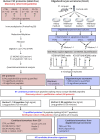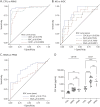CD138 as a Specific CSF Biomarker of Multiple Sclerosis
- PMID: 38669615
- PMCID: PMC11057439
- DOI: 10.1212/NXI.0000000000200230
CD138 as a Specific CSF Biomarker of Multiple Sclerosis
Abstract
Background and objectives: The aim of this study was to identify novel biomarkers for multiple sclerosis (MS) diagnosis and prognosis, addressing the critical need for specific and prognostically valuable markers in the field.
Methods: We conducted an extensive proteomic investigation, combining analysis of (1) CSF proteome from symptomatic controls, fast and slow converters after clinically isolated syndromes, and patients with relapsing-remitting MS (n = 10 per group) using label-free quantitative proteomics and (2) oligodendrocyte secretome changes under proinflammatory or proapoptotic conditions using stable isotope labeling by amino acids in cell culture. Proteins exhibiting differential abundance in both proteomic analyses were combined with other putative MS biomarkers, yielding a comprehensive list of 87 proteins that underwent quantification through parallel reaction monitoring (PRM) in a novel cohort, comprising symptomatic controls, inflammatory neurologic disease controls, and patients with MS at various disease stages (n = 10 per group). The 11 proteins that passed this qualification step were subjected to a new PRM assay within an expanded cohort comprising 158 patients with either MS at different disease stages or other inflammatory or noninflammatory neurologic disease controls.
Results: This study unveiled a promising biomarker signature for MS, including previously established candidates, such as chitinase 3-like protein 1, chitinase 3-like protein 2, chitotriosidase, immunoglobulin kappa chain region C, neutrophil gelatinase-associated lipocalin, and CD27. In addition, we identified novel markers, namely cat eye syndrome critical region protein 1 (adenosine deaminase 2, a therapeutic target in multiple sclerosis) and syndecan-1, a proteoglycan, also known as plasma cell surface marker CD138 and acting as chitinase 3-like protein 1 receptor implicated in inflammation and cancer signaling. CD138 exhibited good diagnostic accuracy in distinguishing MS from inflammatory neurologic disorders (area under the curve [AUC] = 0.85, CI 0.75-0.95). CD138 immunostaining was also observed in the brains of patients with MS and cultured oligodendrocyte precursor cells but was absent in astrocytes.
Discussion: These findings identify CD138 as a specific CSF biomarker for MS and suggest the selective activation of the chitinase 3-like protein 1/CD138 pathway within the oligodendrocyte lineage in MS. They offer promising prospects for improving MS diagnosis and prognosis by providing much-needed specificity and clinical utility.
Classification of evidence: This study provides Class II evidence that CD138 distinguishes multiple sclerosis from other inflammatory neurologic disorders with an AUC of 0.85 (95% CI 0.75-0.95).
Conflict of interest statement
G. Hinsinger, L. Du Trieu de Terdonck, S. Urbach, N. Salvetat, M. Rival, M. Galoppin, C. Ripoll, R. Cezar, S. Laurent-Chabalier, C. Demattei, H. Agherbi, G. Castelnovo, S. Lehmann, V. Rigau, and P. Marin have nothing to disclose; E. Thouvenot has received honoraria, travel grants, or research grants from the following pharmaceutical companies: Actelion, Biogen, BMS, Janssen-Cilag, Merck-Serono, Novartis, Roche, and Sanofi. Go to
Figures





References
Publication types
MeSH terms
Substances
LinkOut - more resources
Full Text Sources
Research Materials
Miscellaneous
